Luận án Thử nghiệm can thiệp của dược sỹ lâm sàng vào việc sử dụng vancomycin nhằm đảm bảo hiệu quả và an toàn trong điều trị tại bệnh viện Bạch Mai
Vancomycin, một kháng sinh nhóm glycopeptid đã được dùng điều trị nhiễm
khuẩn nặng gây ra bởi vi khuẩn Gr (+) kháng kháng sinh nhóm β – lactam. Hiện
nay, vancomycin là thuốc lựa được lựa chọn hàng đầu cho các bệnh nhiễm khuẩn
do tụ cầu vàng kháng methicillin (MRSA) và cầu khuẩn ruột kháng ampicillin. Tuy
nhiên, ngay từ khi mới được đưa vào sử dụng, độc tính trên thính giác và thận của
vancomycin là một vấn đề được quan tâm hàng đầu [76].
Những năm qua, sử dụng vancomycin ngày càng phổ biến với sự gia tăng
nhiễm trùng bệnh viện do vi khuẩn Gram (+) kháng β-lactam. Việc sử dụng
vancomycin rộng rãi là một trong những nguyên nhân dẫn đến phát triển các chủng
vi khuẩn kháng thuốc. Ở các nước Châu Âu, cầu khuẩn ruột đề kháng vancomycin
được ghi nhận với tỉ lệ khác nhau, dao động từ <1% đến >30% [38]. Ở Mỹ, cầu
khuẩn ruột đề kháng vancomycin lên tới 33% [14],[51]. Đối với tụ cầu vàng, sự
xuất hiện các chủng tụ cầu vàng giảm nhạy cảm với vancomycin – Vancomycin
Intermediate Staphylococcus aureus (VISA), tụ cầu đề kháng trung gian dị chủng
với vancomycin- hetero Vancomycin Intermediate Staphylococcus aureus (hVISA)
đang là thách thức lớn cho các nhà lâm sàng. Tỉ lệ hVISA lưu hành tại Châu Á dao
động trong khoảng 2,1 đến 8,2% [106]. Tụ cầu vàng đề kháng vancomycin hiện nay
chưa cao, đang dừng ở mức báo cáo ca lâm sàng đơn lẻ [25]. Tuy nhiên, thất bại
trong điều trị có xu hướng gia tăng trên những bệnh nhân có MIC vancomycin với
vi khuẩn gây bệnh cao [107].
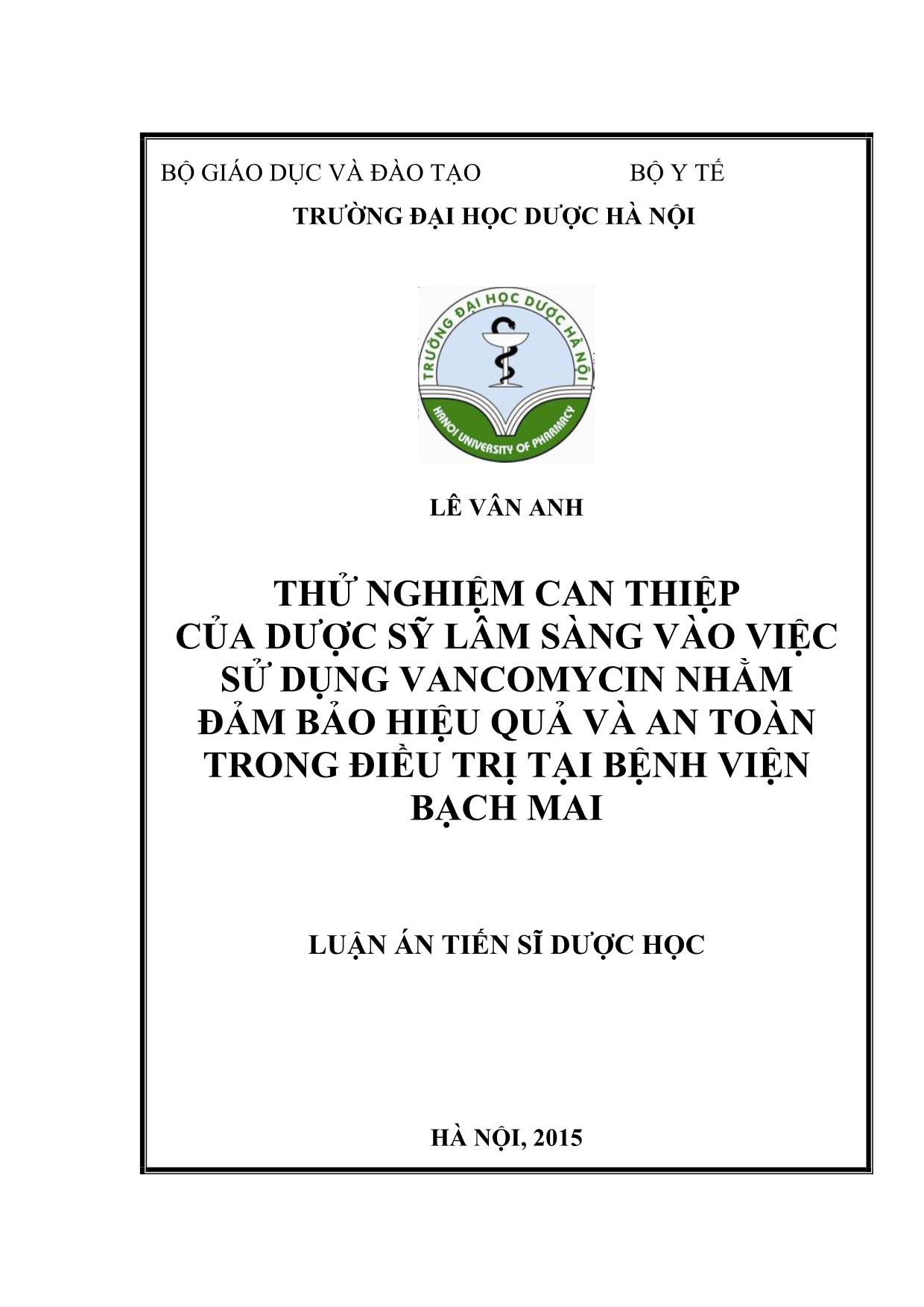
Trang 1
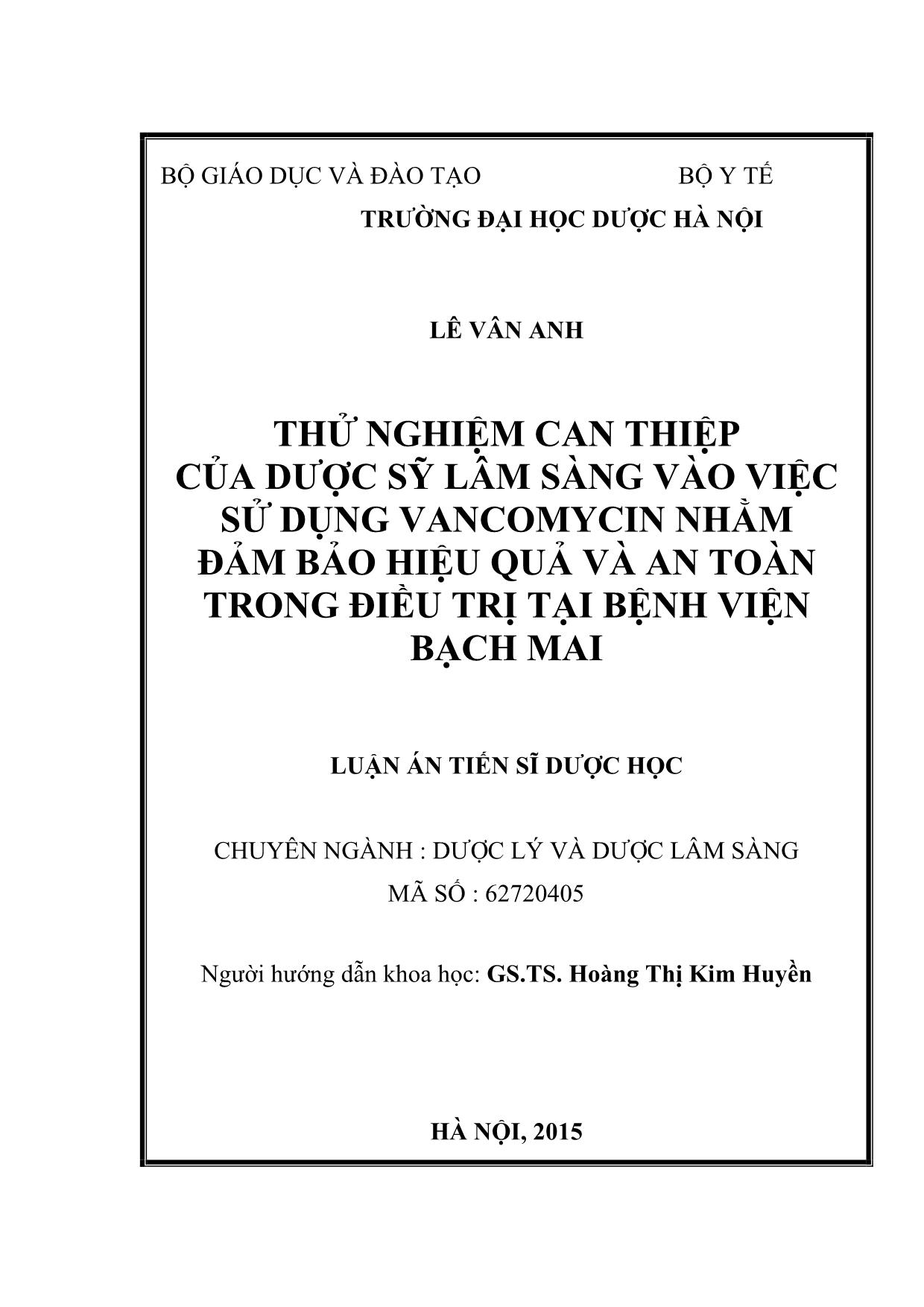
Trang 2
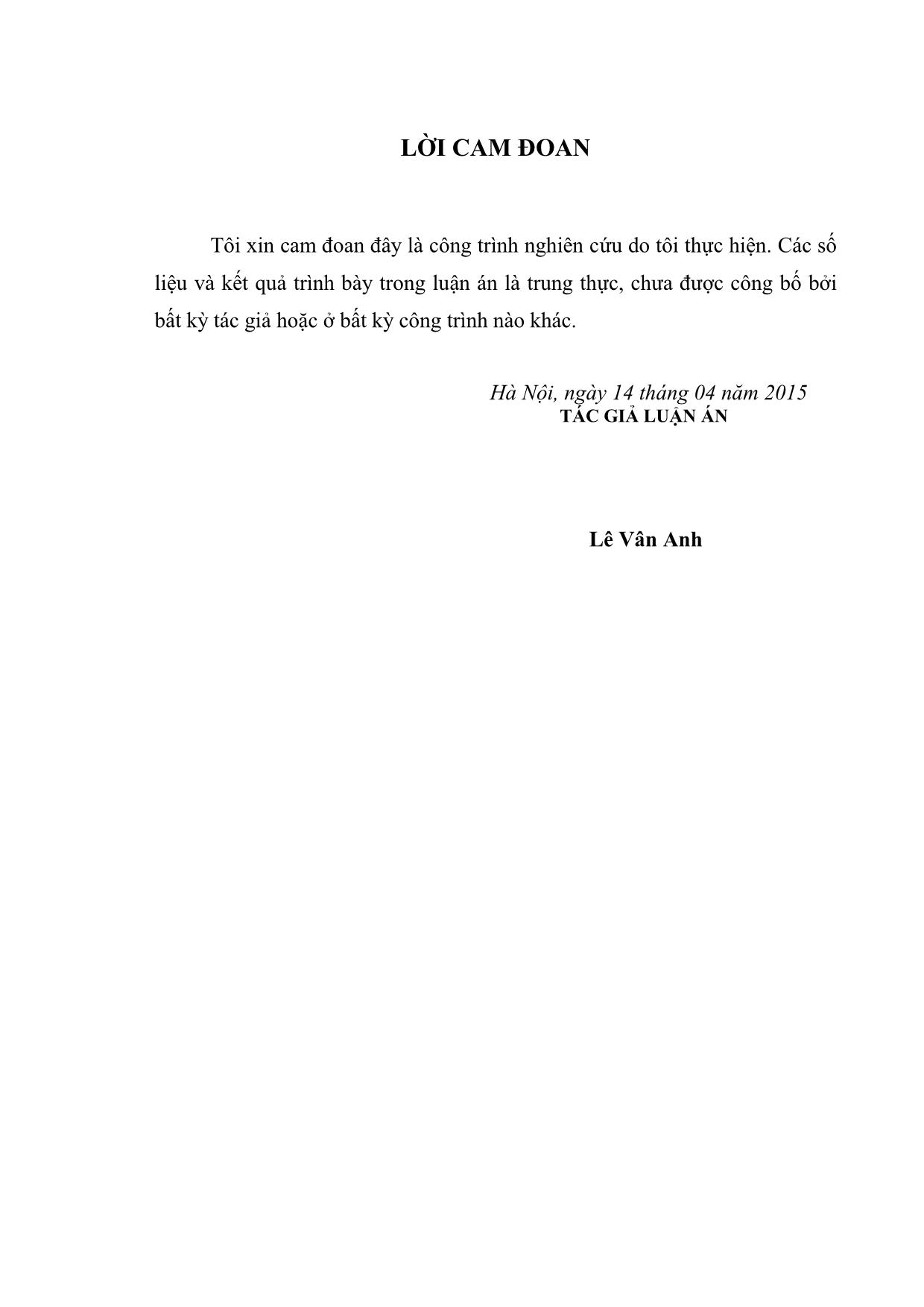
Trang 3
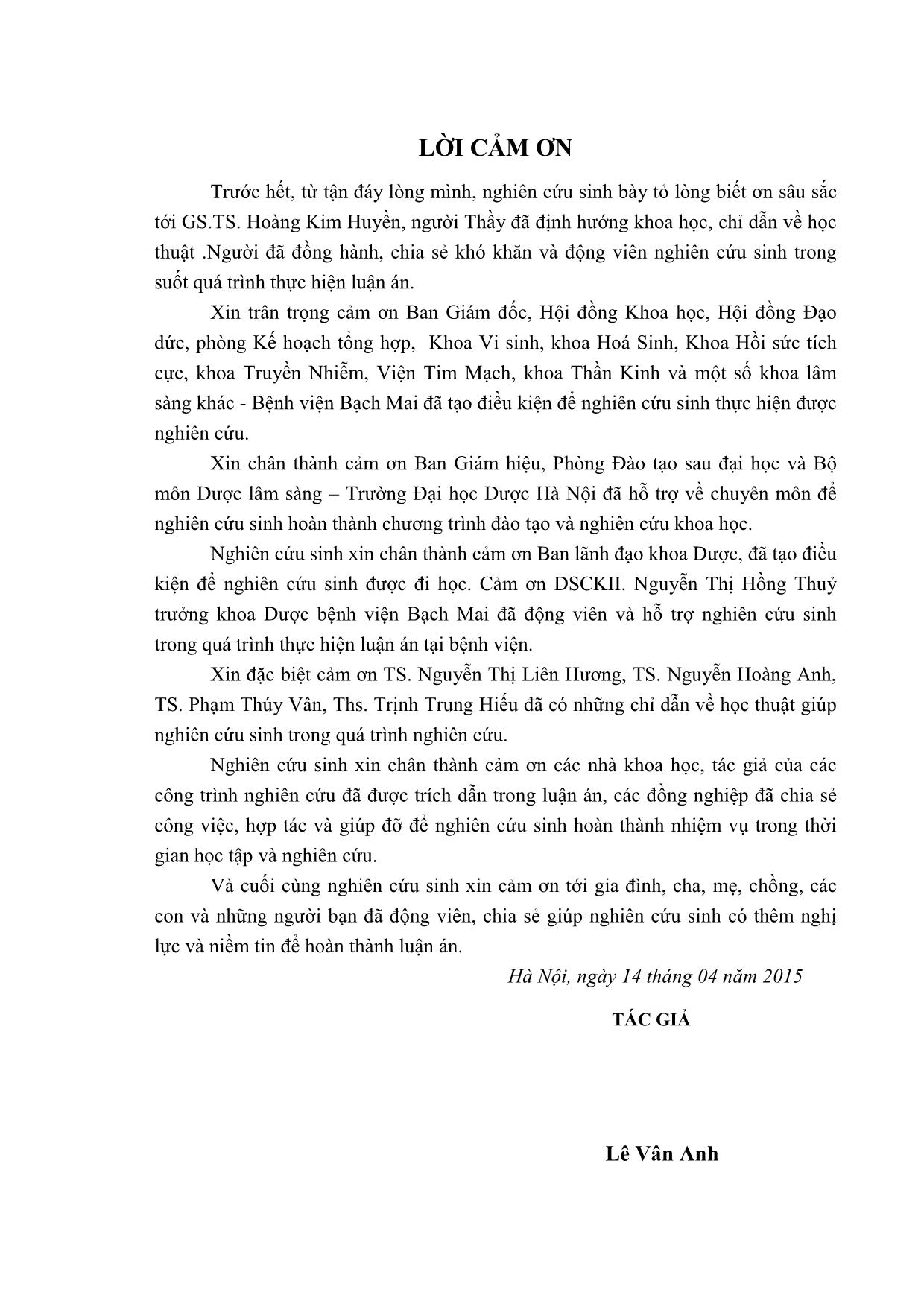
Trang 4
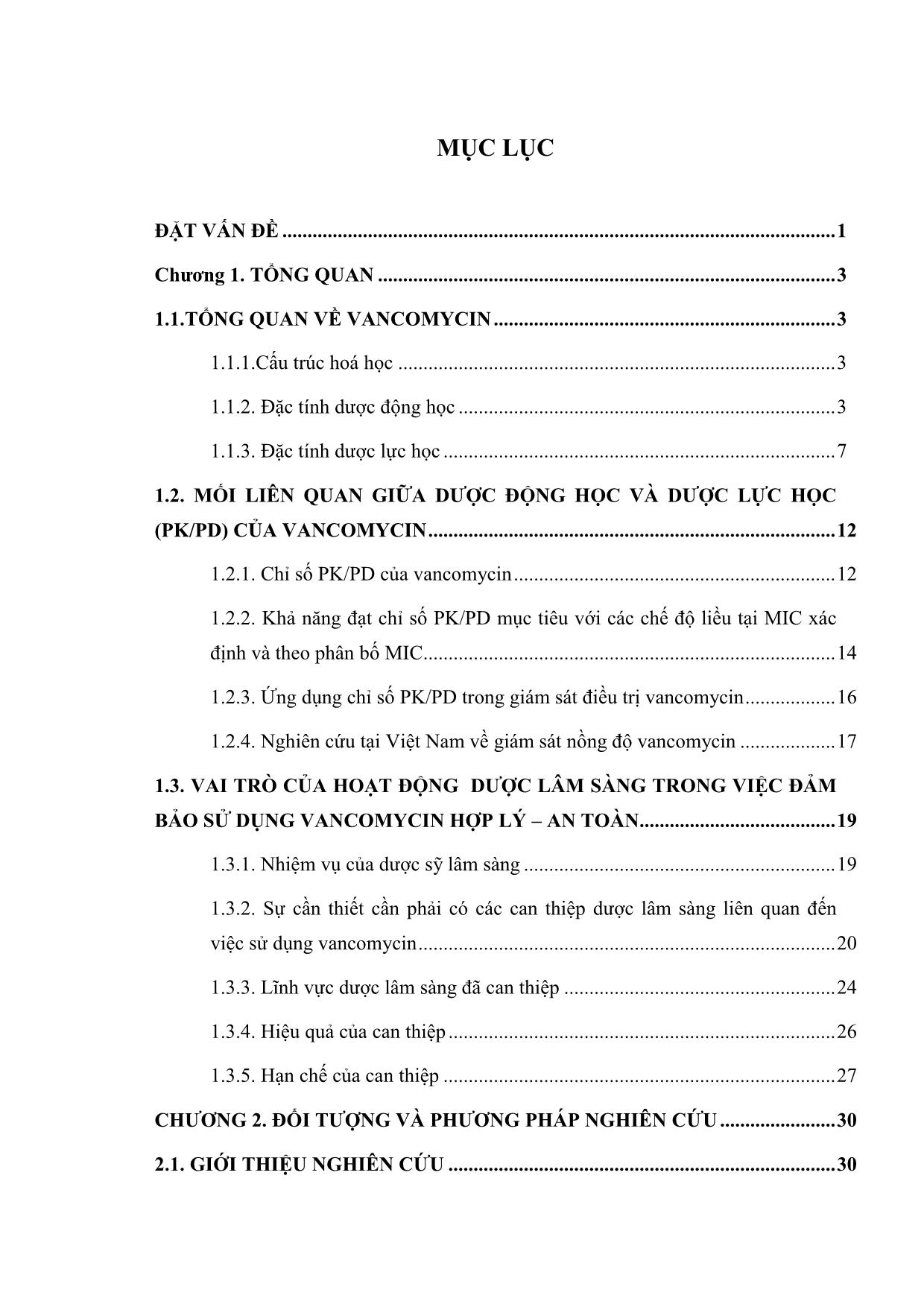
Trang 5
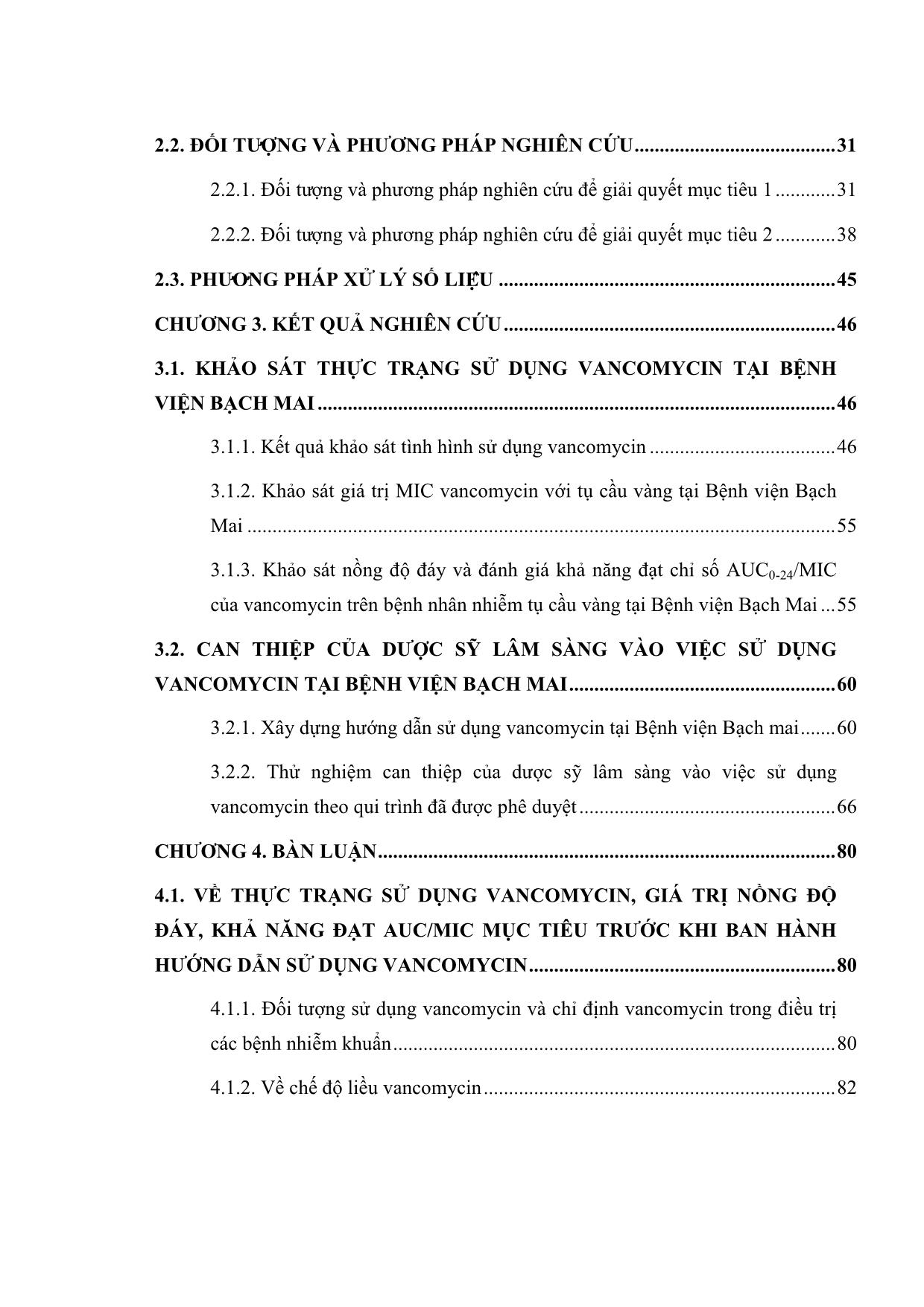
Trang 6
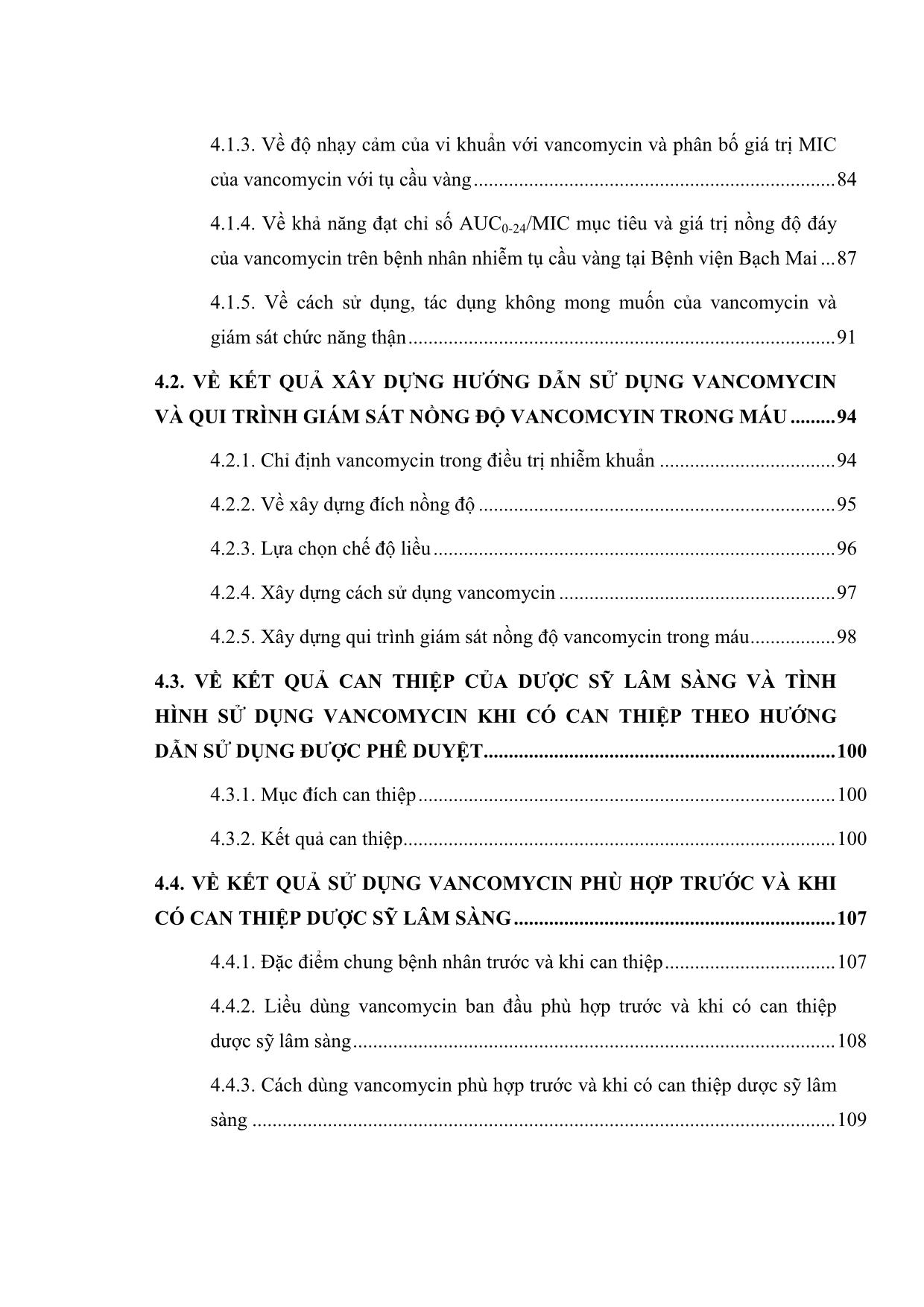
Trang 7
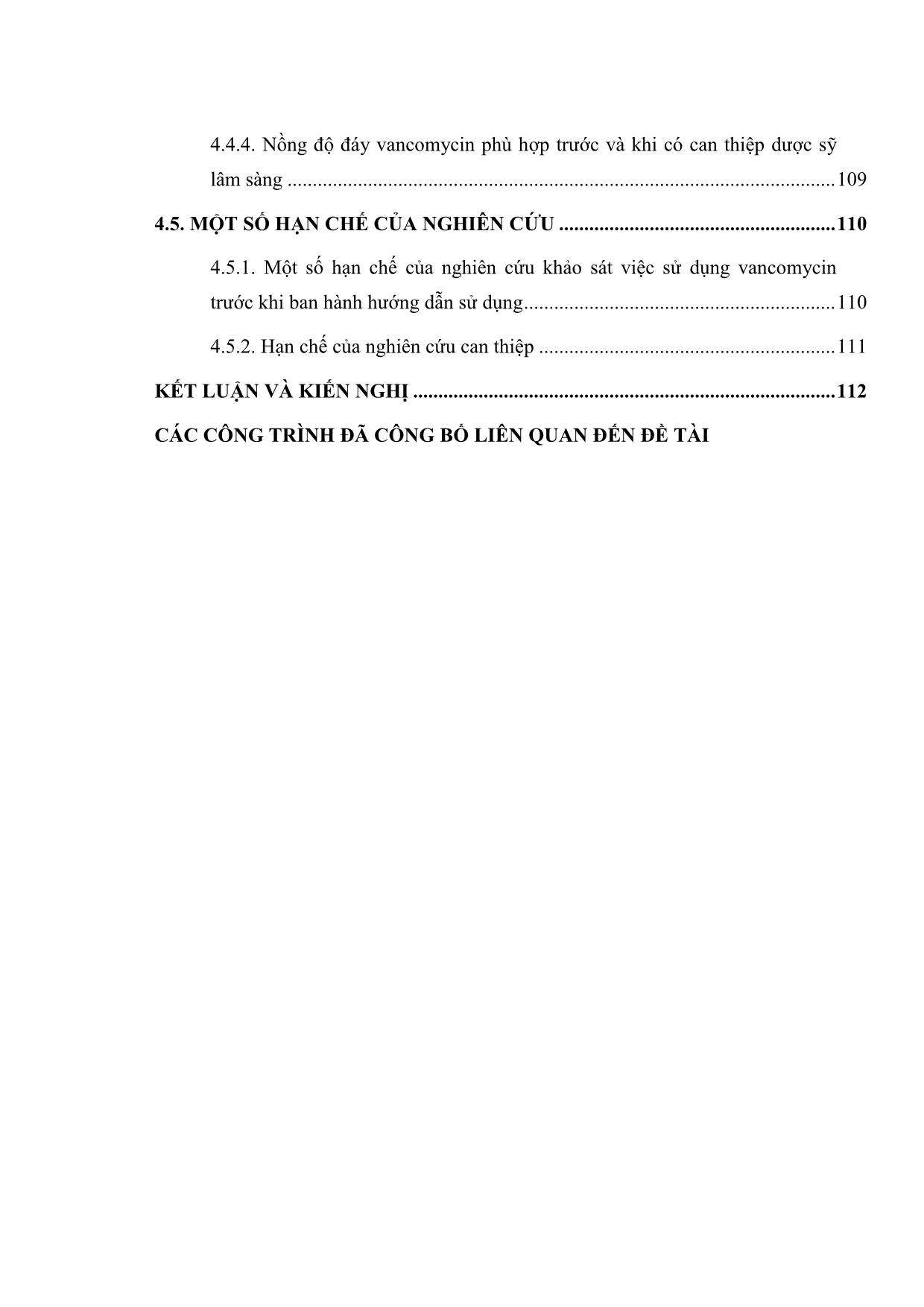
Trang 8
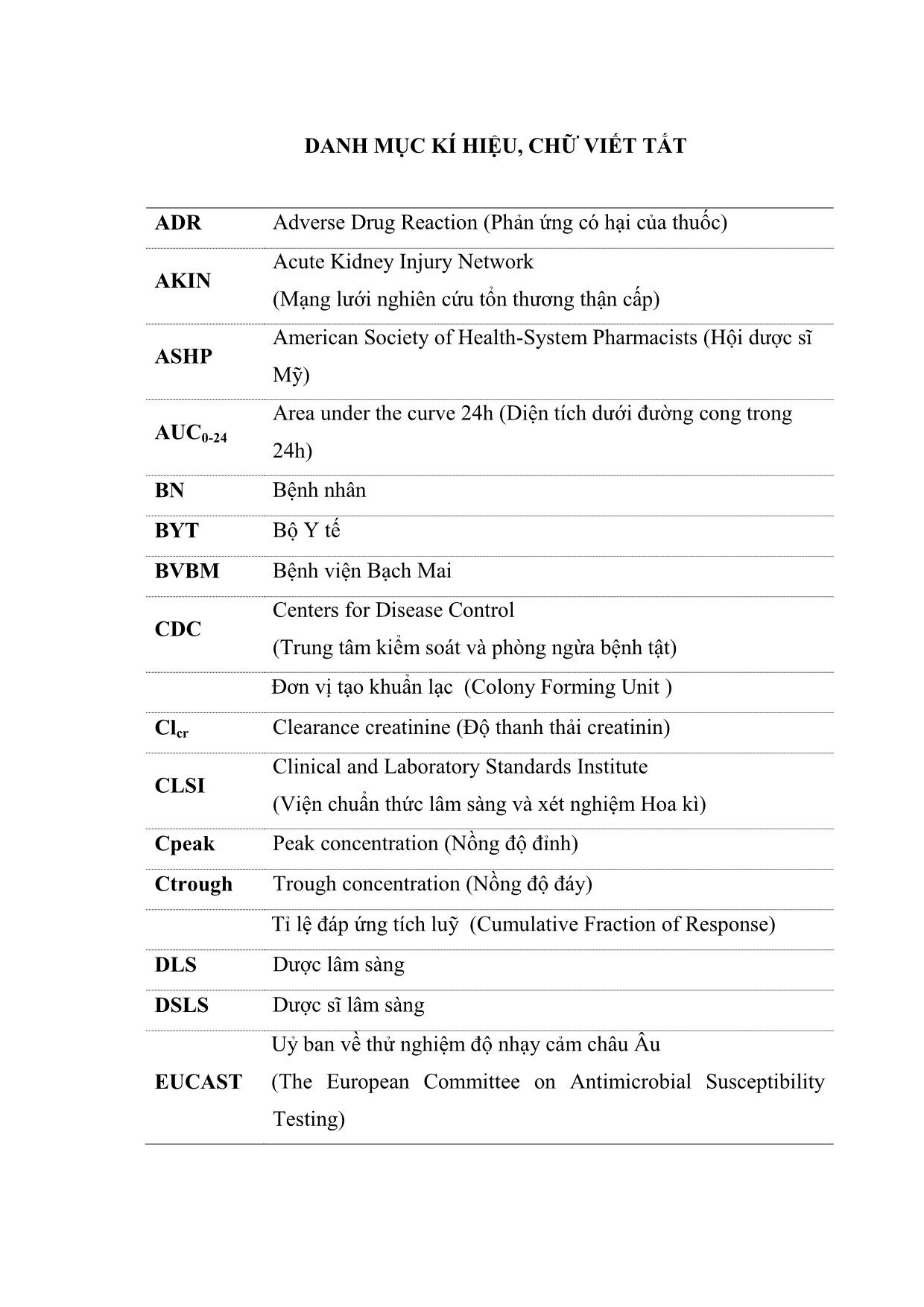
Trang 9
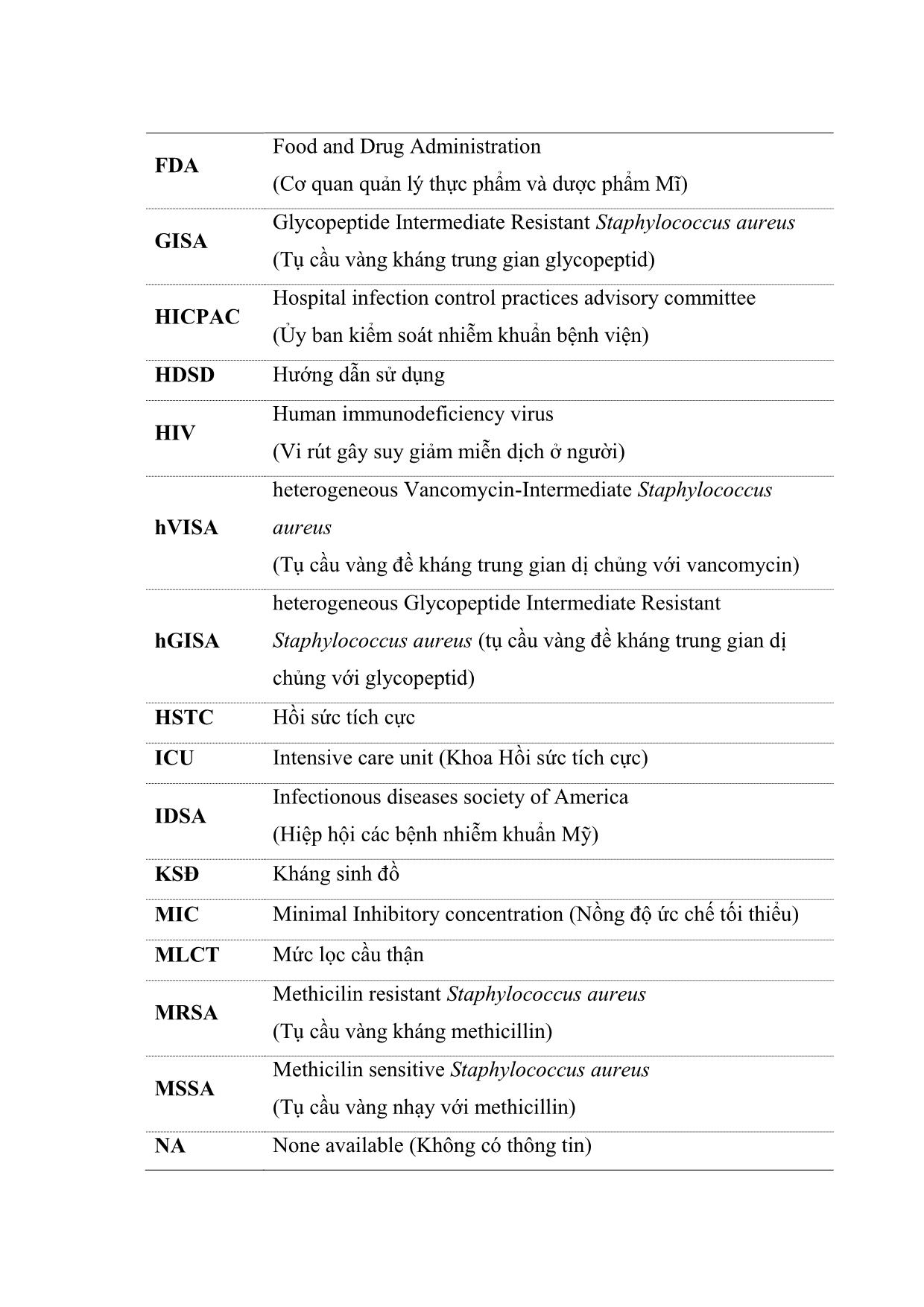
Trang 10
Tải về để xem bản đầy đủ
Tóm tắt nội dung tài liệu: Luận án Thử nghiệm can thiệp của dược sỹ lâm sàng vào việc sử dụng vancomycin nhằm đảm bảo hiệu quả và an toàn trong điều trị tại bệnh viện Bạch Mai
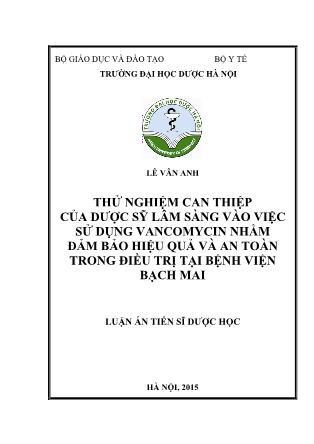
BỘ GIÁO DỤC VÀ ĐÀO TẠO BỘ Y TẾ TRƢỜNG ĐẠI HỌC DƢỢC HÀ NỘI LÊ VÂN ANH THỬ NGHIỆM CAN THIỆP CỦA DƢỢC SỸ LÂM SÀNG VÀO VIỆC SỬ DỤNG VANCOMYCIN NHẰM ĐẢM BẢO HIỆU QUẢ VÀ AN TOÀN TRONG ĐIỀU TRỊ TẠI BỆNH VIỆN BẠCH MAI LUẬN ÁN TIẾN SĨ DƢỢC HỌC HÀ NỘI, 2015 BỘ GIÁO DỤC VÀ ĐÀO TẠO BỘ Y TẾ TRƢỜNG ĐẠI HỌC DƢỢC HÀ NỘI LÊ VÂN ANH THỬ NGHIỆM CAN THIỆP CỦA DƢỢC SỸ LÂM SÀNG VÀO VIỆC SỬ DỤNG VANCOMYCIN NHẰM ĐẢM BẢO HIỆU QUẢ VÀ AN TOÀN TRONG ĐIỀU TRỊ TẠI BỆNH VIỆN BẠCH MAI LUẬN ÁN TIẾN SĨ DƢỢC HỌC CHUYÊN NGÀNH : DƯỢC LÝ VÀ DƯỢC LÂM SÀNG MÃ SỐ : 62720405 Người hướng dẫn khoa học: GS.TS. Hoàng Thị Kim Huyền HÀ NỘI, 2015 LỜI CAM ÐOAN Tôi xin cam đoan đây là công trình nghiên cứu do tôi thực hiện. Các số liệu và kết quả trình bày trong luận án là trung thực, chưa được công bố bởi bất kỳ tác giả hoặc ở bất kỳ công trình nào khác. Hà Nội, ngày 14 tháng 04 năm 2015 TÁC GIẢ LUẬN ÁN Lê Vân Anh LỜI CẢM ƠN Trước hết, từ tận đáy lòng mình, nghiên cứu sinh bày tỏ lòng biết ơn sâu sắc tới GS.TS. Hoàng Kim Huyền, người Thầy đã định hướng khoa học, chỉ dẫn về học thuật .Người đã đồng hành, chia sẻ khó khăn và động viên nghiên cứu sinh trong suốt quá trình thực hiện luận án. Xin trân trọng cảm ơn Ban Giám đốc, Hội đồng Khoa học, Hội đồng Đạo đức, phòng Kế hoạch tổng hợp, Khoa Vi sinh, khoa Hoá Sinh, Khoa Hồi sức tích cực, khoa Truyền Nhiễm, Viện Tim Mạch, khoa Thần Kinh và một số khoa lâm sàng khác - Bệnh viện Bạch Mai đã tạo điều kiện để nghiên cứu sinh thực hiện được nghiên cứu. Xin chân thành cảm ơn Ban Giám hiệu, Phòng Đào tạo sau đại học và Bộ môn Dược lâm sàng – Trường Đại học Dược Hà Nội đã hỗ trợ về chuyên môn để nghiên cứu sinh hoàn thành chương trình đào tạo và nghiên cứu khoa học. Nghiên cứu sinh xin chân thành cảm ơn Ban lãnh đạo khoa Dược, đã tạo điều kiện để nghiên cứu sinh được đi học. Cảm ơn DSCKII. Nguyễn Thị Hồng Thuỷ trưởng khoa Dược bệnh viện Bạch Mai đã động viên và hỗ trợ nghiên cứu sinh trong quá trình thực hiện luận án tại bệnh viện. Xin đặc biệt cảm ơn TS. Nguyễn Thị Liên Hương, TS. Nguyễn Hoàng Anh, TS. Phạm Thúy Vân, Ths. Trịnh Trung Hiếu đã có những chỉ dẫn về học thuật giúp nghiên cứu sinh trong quá trình nghiên cứu. Nghiên cứu sinh xin chân thành cảm ơn các nhà khoa học, tác giả của các công trình nghiên cứu đã được trích dẫn trong luận án, các đồng nghiệp đã chia sẻ công việc, hợp tác và giúp đỡ để nghiên cứu sinh hoàn thành nhiệm vụ trong thời gian học tập và nghiên cứu. Và cuối cùng nghiên cứu sinh xin cảm ơn tới gia đình, cha, mẹ, chồng, các con và những người bạn đã động viên, chia sẻ giúp nghiên cứu sinh có thêm nghị lực và niềm tin để hoàn thành luận án. Hà Nội, ngày 14 tháng 04 năm 2015 TÁC GIẢ Lê Vân Anh MỤC LỤC ĐẶT VẤN ĐỀ .............................................................................................................. 1 Chƣơng 1. TỔNG QUAN ........................................................................................... 3 1.1.TỔNG QUAN VỀ VANCOMYCIN .................................................................... 3 1.1.1.Cấu trúc hoá học ....................................................................................... 3 1.1.2. Đặc tính dược động học ........................................................................... 3 1.1.3. Đặc tính dược lực học .............................................................................. 7 1.2. MỐI LIÊN QUAN GIỮA DƢỢC ĐỘNG HỌC VÀ DƢỢC LỰC HỌC (PK/PD) CỦA VANCOMYCIN ................................................................................. 12 1.2.1. Chỉ số PK/PD của vancomycin ................................................................ 12 1.2.2. Khả năng đạt chỉ số PK/PD mục tiêu với các chế độ liều tại MIC xác định và theo phân bố MIC.................................................................................. 14 1.2.3. Ứng dụng chỉ số PK/PD trong giám sát điều trị vancomycin .................. 16 1.2.4. Nghiên cứu tại Việt Nam về giám sát nồng độ vancomycin ................... 17 1.3. VAI TRÒ CỦA HOẠT ĐỘNG DƢỢC LÂM SÀNG TRONG VIỆC ĐẢM BẢO SỬ DỤNG VANCOMYCIN HỢP LÝ – AN TOÀN....................................... 19 1.3.1. Nhiệm vụ của dược sỹ lâm sàng .............................................................. 19 1.3.2. Sự cần thiết cần phải có các can thiệp dược lâm sàng liên quan đến việc sử dụng vancomycin ................................................................................... 20 1.3.3. Lĩnh vực dược lâm sàng đã can thiệp ...................................................... 24 1.3.4. Hiệu quả của can thiệp ............................................................................. 26 1.3.5. Hạn chế của can thiệp .............................................................................. 27 CHƢƠNG 2. ĐỐI TƢỢNG VÀ PHƢƠNG PHÁP NGHIÊN CỨU ....................... 30 2.1. GIỚI THIỆU NGHIÊN CỨU ............................................................................. 30 2.2. ĐỐI TU ỢNG VÀ PHƢƠNG PHÁP NGHIÊN CỨU ........................................ 31 2.2.1. Đối tu ợng và phương pháp nghiên cứu để giải quyết mục tiêu 1 ............ 31 2.2.2. Đối tu ợng và phương pháp nghiên cứu để giải quyết mục tiêu 2 ............ 38 2.3. PHU O NG PHÁP XỬ LÝ SỐ LIẸ U ................................................................... 45 CHƢƠNG 3. KẾT QUẢ NGHIÊN CỨU .................................................................. 46 3.1. KHẢO SÁT THỰC TRẠNG SỬ DỤNG VANCOMYCIN TẠI BỆNH VIỆN BẠCH MAI ....................................................................................................... 46 3.1.1. Kết quả khảo sát tình hình sử dụng vancomycin ..................................... 46 3.1.2. Khảo sát giá trị MIC vancomycin với tụ cầu vàng tại Bệnh viện Bạch Mai ................................................................................................................. ... of 11 antimicrobial agents and bactericidal activities of vancomycin and daptomycin against invasive methicillin-resistant Staphylococcus aureus isolates obtained from 1999 through 2006", Antimicrob Agents Chemother, 52(2), pp. 757-60. 55. Jean-Damien Ricard, Michel Wolff, Lacherade Jean-Claude, et al.,(2007), "Levels of Vancomycin in Cerebrospinal Fluid of Adult Patients Receiving Adjunctive Corticosteroids to Treat Pneumococcal Meningitis: A Prospective Multicenter Observational Study", Clinical Infection Disease, 44, pp. 250-255. 56. Junior S.M., Correa L., Marra R.A., et al., (2007), "Analysis of vancomycin use and associated risk factors in a university teaching hospital: a prospective cohort study", BMC Infectious Diseases 7(88), pp. 2334-7. 57. Khatib R., Riederer K., Shemes S., et al., (2013), "Correlation of methicillin- resistant Staphylococcus aureus vancomycin minimal inhibitory concentration results by Etest and broth microdilution methods with population analysis profile: lack of Etest overestimation of the MIC", Eur J Clin Microbiol Infect Dis, 32(6), pp. 803-6. 58. Kim J.M., Park S.J., Lee Y.M., et at., (2014), "Development of clinical pharmacy services for intensive care units in Korea", SpingerPlus, 3(34), pp. 1-7. 59. Kitzis M.D., Goldstein F.W., (2006), "Monitoring of vancomycin serum levels for the treatment of staphylococcal infections", Clin Microbiol Infect 12, pp. 92-5. 60. Kullar R., et al., (2011), "Validation of the Effectiveness of a vancomycin nomogram in a chieving target trough concentrations of 15-20 mg/L suggested by the vancomycin consensus guidelines", Pharmacotherapy, 31(5), pp. 441-448. 61. Kuti J.L., Kiffer C. R.V., Mendes C.M.F., et al., (2007), "Pharmacodynamic comparison of linezolid, teicoplanin and vancomycin against clinical isolates of Staphylococcus aureus and coagulase-negative staphylococci collected from hospitals in Brazil", Clin Microbiol Infect 14, pp. 116-123. 62. Legal M., Wan M., (2010), "Influence of age on frequency of vancomycin dosing", Can J Hosp Pharm, 63(1), pp. 13-19. 63. Li J., Udy A.A., Kirkpatrick C.M., et al., (2012), "Improving vancomycin prescription in critical illness through a drug use evaluation process: a weight-based dosing intervention study", Int J Antimicrob Agents, 39(1), pp. 69-72. 64. Lie Katherine, et al. (2011), "Low adherence to vancomycin guidelines at an Australian paediatric hospital", Journal of pharmacy practice and research, 41, pp. 278-82. 65. Lipsky B.A., Catherin A.B., MacDonal L.L., (1999), "Improving the appropriateness of vancomycin use by sequential interventions", AJIC, 27(2), pp. 84-90. 66. Liu C., Bayer A., Cosgrove S. E., et al., (2011), "Clinical practice guidelines by the Infectious Diseases society of America for the treatment of methicillin-resistant Staphylococcus aureus infections in adults and children", Clin Infect Dis, 52(3), pp. e18-55. 67. Liu C., Chambers H. F., (2003), "Staphylococcus aureus with Heterogeneous Resistance to Vancomycin: Epidemiology, Clinical Significance, and Critical Assessment of Diagnostic Methods", Antimicrob Agents Chemother, 47(10), pp. 3040-3045. 68. Lodise T. P., Drusano G. L., Butterfield J. M., et al., (2011), "Penetration of vancomycin into epithelial lining fluid in healthy volunteers", Antimicrob Agents Chemother, 55(12), pp. 5507-11. 69. Lodise T. P., Graves J., Evans A., et al., (2008), "Relationship between vancomycin MIC and failure among patients with methicillin-resistant Staphylococcus aureus bacteremia treated with vancomycin", Antimicrob Agents Chemother, 52(9), pp. 3315-20. 70. Makowsky Mark J, et al., (2004), " An assessment of vancomycin use in 2 tertiary care hospitals ", Can J Hosp pharm, 57, pp. 150-7. 71. Mandell, Douglas, Bennett ' s (2010), Principles and Practice of Infectious Diseases, Churchill Livingstone Elsevier, (7 th edition), pp. 449-459. 72. Mangili A., Bica I., Snydman D.R., et al., (2005), "Daptomycin-resistant, methicillin-resistant Staphylococcus aureus bacteremia", Clin Infect Dis 40, pp. 1058-60. 73. Maor Y., Hagin M., Belausov N., et al., (2009), "Clinical features of heteroresistant vancomycin-intermediate Staphylococcus aureus bacteremia versus those of methicillin-resistant S. aureus bacteremia", J Infect Dis, 199(5), pp. 619-24. 74. Martin C., Alay A M., Mallet M.N., et al., (1994), "Penetration of Vancomycin into Mediastinal and Cardiac Tissues in Humans", Antimicrobial Agents and Chemotherapy pp. 396-399. 75. Matsumoto Kazuaki, Takesue Yoshio, Ohmagari Norio, et al., (2013), "Practice guidelines for therapeutic drug monitoring of vancomycin: a consensus review of the Japanese Society of Chemotherapy and the Japanese Society of Therapeutic Drug Monitoring", J Infect Chemother, 19(3), pp. 365-80. 76. Matzke R.G, Zhanel G.G, D.R.P and Guay, (1986), "Clinical Pharmacokinetics of vancomycin ", Clinical Pharmacokinetics 11, pp. 257- 282. 77. May A.K., Melton S.M., McGwin G., et al., (2000), "Reduction of vancomycin-resistant enterococcal infections by limitation of broad- spectrum cephalosporin use in a trauma and burn intensive care unit", Shock 2000, 14(3), pp. 259-64. 78. Melanson S. E., Mijailovic A. S., Wright A. P., et at., (2013), "An intervention to improve the timing of vancomycin levels", Am J Clin Pathol, 140(6), pp. 801-6. 79. Melo D.O., (2007), "Vancomycin use in a hospital with high prevalence of MRSA: comparison with HICPAC", The Brazilian Journal of Infectious Diseases 11(1), pp. 53-56. 80. Melo D.O, Ribeiro Eliane, (2009), "Vancomycin use in a Brazilian teaching hospital: comparison with the Hospital Infection Control Practices Advisory Committee Guidelines (HICPAC)", The Brazilian Journal of Infectious Diseases 13(3), pp. 161-164. 81. Minejima E., Choi J., Beringer P., et al., (2011), "Applying new diagnostic criteria for acute kidney injury to facilitate early identification of nephrotoxicity in vancomycin-treated patients", Antimicrob Agents Chemother, 55(7), pp. 3278-83. 82. Minkute R., Briedis V., Steponaviciute R., et al., (2013), "Augmented renal clearance evolving risk factor to consider during the treatment with vancomycin", J Clin Pharm Ther, 38(6), pp. 462-7. 83. Misan G.M.H., Martin E.D., Smith E.R., et al., (1990), "Drug utilization review in a teaching hospital: experience with vancomycin ", Eur J Clin Pharmacol 39, pp. 457-461. 84. Moellering R.C., Krogstad D.J., Greenblatt D.J., (1981), "Vancomycin therapy in patients with impaired renal function: a nomogram for dosage", Ann Intern Med, 93(3), pp. 343-346. 85. Moise-Broder P.A., Alan Forrest, Mary C., et al., ( 2004), "Pharmacodynamics of Vancomycin and Other Antimicrobials in Patients with Staphylococcus aureus Lower Respiratory Tract Infections", Clin. Pharmacokinet., 43(13), pp. 925-942. 86. Mouton J. W., Dudley M. N., Cars O., et al., (2005), "Standardization of pharmacokinetic/pharmacodynamic (PK/PD) terminology for anti-infective drugs: an update", J Antimicrob Chemother, 55(5), pp. 601-7. 87. Neely M. N., Youn G., Jones B., et al., (2014), "Are vancomycin trough concentrations adequate for optimal dosing?", Antimicrob Agents Chemother, 58(1), pp. 309-16. 88. Nightingale C.H., Ambrose P.G., Drusano G.I., (2007), Antimicrobial Pharmacodynamics in Theory and Clinical Practice, 2 nd edition, Informa Healthcare USA, Inc, pp. 177-205. 89. Oracle® "Crystal Ball, Fusion Edition (Version 11.1.2.3.00)". Crystal Ball User's Guide, 11.1.2. Last accessed 16 Jan 2012. 90. Parker M.T., Jevons M.P., (1964), "A survey of methicillin resistance in Staphylococcus aureus", Postgrad Med J, 40, pp. 170-8. 91. Patel N., Pai M. P., Rodvold K. A., et al., (2011), "Vancomycin: we can't get there from here", Clin Infect Dis, 52(8), pp. 969-74. 92. Phillips C. J., Doan H., Quinn S., et al., (2013), "An educational intervention to improve vancomycin prescribing and monitoring", Int J Antimicrob Agents, 41(4), pp. 393-4. 93. Revilla N., Martin-Suarez A., Perez M. P., et al., (2010), "Vancomycin dosing assessment in intensive care unit patients based on a population pharmacokinetic/pharmacodynamic simulation", Br J Clin Pharmacol, 70(2), pp. 201-12. 94. Robles-Piedras A. L., Lopez E., Gonzalez H., (2009), "Therapeutic Drug Monitoring of Vancomycin", Proc.West.Pharmacol.Soc, 52, pp. 21-23. 95. Rosini J. M., Grovola M. R., Levine B. J., et al., (2013), "Prescribing habits of vancomycin in the Emergency Department: are we dosing appropriately?", J Emerg Med, 44(5), pp. 979-84. 96. Roustit Matthieu, et al. (2010), "Evaluation of glycopeptide prescription and therapeutic drug monitoring at a university hospital", Scandinavian Journal of infection diseases, 2, pp. 177-184. 97. Rybak M., Lomaestro B., Rotschafer J. C., Moellering R. Jr., et al., (2009), "Therapeutic monitoring of vancomycin in adult patients: a consensus review of the American Society of Health-System Pharmacists, the Infectious Diseases Society of America, and the Society of Infectious Diseases Pharmacists", Am J Health Syst Pharm, 66(1), pp. 82-98. 98. Rybak M.J., (2006), "The Pharmacokinetic and Pharmacodynamic Properties of vancomycin", Clinical Infectious Diseases, 42, Supplement 1, pp. pp. S35-S39. 99. Sader H. S., Fey P. D., Limaye A. P., et al., (2009), "Evaluation of vancomycin and daptomycin potency trends (MIC creep) against methicillin-resistant Staphylococcus aureus isolates collected in nine U.S. medical centers from 2002 to 2006", Antimicrob Agents Chemother, 53(10), pp. 4127-32. 100. Sader H. S., Jones R. N., Rossi K. L., Rybak M. J., (2009), "Occurrence of vancomycin-tolerant and heterogeneous vancomycin-intermediate strains (hVISA) among Staphylococcus aureus causing bloodstream infections in nine USA hospitals", J Antimicrob Chemother, 64(5), pp. 1024-8. 101. Sakoulas G., Eliopoulos G.M., Moellering R.C., et al., (2003), "Staphylococcus aureus Accessory Gene Regulator (agr) Group II: Is There a Relationship to the Development of Intermediate-Level Glycopeptide Resistance", The Journal Infection Disease, 187, pp. 929-938. 102. Sakoulas G., Gold H. S., Cohen R. A., et al., (2006), "Effects of prolonged vancomycin administration on methicillin-resistant Staphylococcus aureus (MRSA) in a patient with recurrent bacteraemia", J Antimicrob Chemother, 57(4), pp. 699-704. 103. Salem A.H. Zhanel G.G., Ibrahim SA, et al., (2014), "A Monte Carlo Simulation Analysis of Ceftobiprole, Dalbavancin, Daptomycin, Tigecycline, Linezolid and Vancomycin Pharmacodynamics Against ICU - Isolated MRSA", Clinical and Experimental Pharmacology and Physiolosy 41, pp. 437-443. 104. Saunders N.J. (1994), "Why monitor peak vancomycin concentration", Lancet, 344, pp. 1748-1750. 105. Sivagnanam, Soupramanien, Deleu, Dirk (2003), "Red man syndrome", Critical Care, 7(2), pp. 119. 106. Song J. H., Hiramatsu K., Suh J. Y., et al., (2004), "Emergence in Asian countries of Staphylococcus aureus with reduced susceptibility to vancomycin", Antimicrob Agents Chemother, 48(12), pp. 4926-8. 107. Soriano A., Marco F., Martinez J.A., et al., (2008), "Influence of Vancomycin Minimum Inhibitory Concentration on the Treatment of Methicillin-Resistant Staphylococcus aureus Bacteremia", Clinical Infectious Diseases 46(2), pp. 193-200. 108. SHPA (Society of Hospital Pharmacy Association), (2005), "SHPA standards of practice for clinical pharmacy", J Pharm Pract Res, 35(2), pp. 122-46. 109. Steinkraus G., White R., Friedrich L., (2007), "Vancomycin MIC creep in non-vancomycin-intermediate Staphylococcus aureus (VISA), vancomycin- susceptible clinical methicillin-resistant S.aureus (MRSA) blood isolates from 2001-05", Journal of Antimicrobial Chemotherapy 60, pp. 788-794. 110. Stevens D.L., (2006), "The Role of Vancomycin in the Treatment Paradigm", Clinical Infectious Diseases, 42, pp. S51-7. 111. Sun H., Maderazo E. G., Krusell A. R., (1993), "Serum protein-binding characteristics of vancomycin", Antimicrob Agents Chemother, 37(5), pp. 1132-1136. 112. Suzuki Y., Kawasaki K., Sato Y., et al., (2012), "Is peak concentration needed in therapeutic drug monitoring of vancomycin? A pharmacokinetic- pharmacodynamic analysis in patients with methicillin-resistant Staphylococcus aureus pneumonia", Chemotherapy, 58(4), pp. 308-12. 113. Thalakada R., Legal M., Lau T.T.Y., et al., (2012), "Development and Validation of a Novel Vancomycin Dosing Nomogram for Achieving High- Target Trough Levels at 2 Canadian Teaching Hospitals", Can J Hosp Pharm 65(3), pp. 180-187. 114. Tsiodras S., Gold H.S., Sakoulas G., et al., (2001), "Linezolid resistance in a clinical isolate of Staphylococcus aureus", Lancet, 358, pp. 207-8. 115. Tsuji B. T., Rybak M. J., Lau K. L., et al., (2007), "Evaluation of accessory gene regulator (agr) group and function in the proclivity towards vancomycin intermediate resistance in Staphylococcus aureus", Antimicrob Agents Chemother, 51(3), pp. 1089-91. 116. Wesner A. R., Brackbill M. L., Coyle L. L., Kidd R. S. (2013), "Prospective trial of a novel nomogram to achieve updated vancomycin trough concentrations", Interdiscip Perspect Infect Dis, 2013, pp. 839456. 117. Wilson A.P.R., (1998), "Comparative safety of teicoplanin and vancomycin", Int J Antimicrobial Agents 10, pp. 143-152. 118. You J.H.S., (2001), "Vancomycin Utilization at a Teaching Hospital in Hong Kong", Am J Health-Syst Pharm, 58, pp. 2167-9. 119. Zaabi Mohamet Al, et al., (2013), "Utilization Pattern of Vancomycin in a University Teaching Hospital in Oman: Comparison with International Guidelines", Tropical Journal of pharmaceutical research 12(1), pp. 117- 121.
File đính kèm:
 luan_an_thu_nghiem_can_thiep_cua_duoc_sy_lam_sang_vao_viec_s.pdf
luan_an_thu_nghiem_can_thiep_cua_duoc_sy_lam_sang_vao_viec_s.pdf

